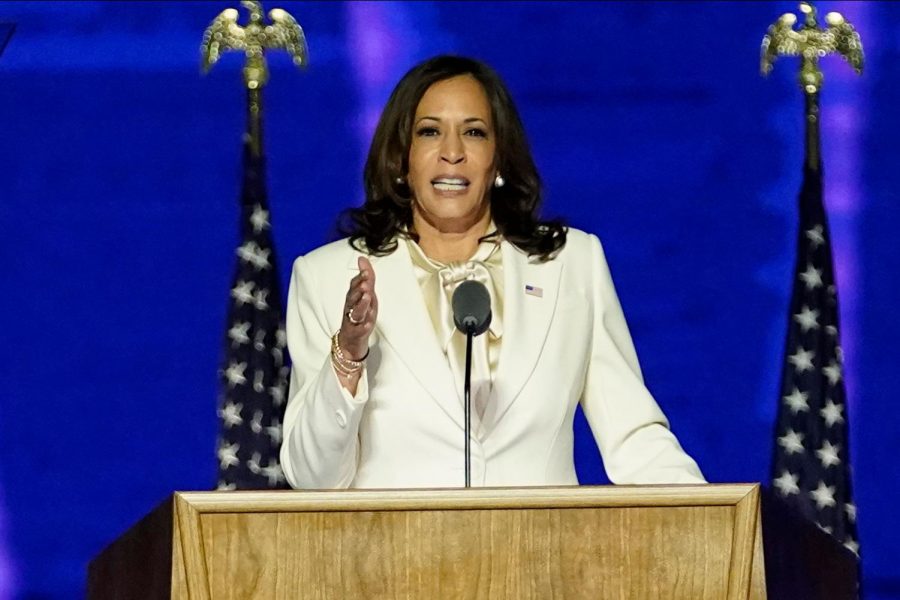Why Kamala Wore White: The Deeper Meaning Behind What Meets the Eye
On the 7th of November, Kamala Harris became the very first woman to be elected Vice President of the United States. That night, she and President-elect Joe Biden delivered inspiring victory speeches to which Kamala wore an all-white ensemble in honor of the suffragettes. Though this doesn’t seem too significant at first glance, her reason has a lot of important historical meaning behind it.
To understand the meaning of Kamala’s clothing, we have to examine 1900s America, when a female vice president was an inconceivable thought. During this time, many social shifts were occurring: more specifically, women fighting for the right to vote. These women were referred to as “suffragettes” because they were activists in the Women’s Suffrage Movement, which was one of the first times women publicly acknowledged the injustice of their lack of access to voting rights and fought for equality. Though many people supported the movement, others saw the suffragettes as unsophisticated radicals because the idea of women playing a role in politics was so unheard of, and because a woman’s place was “in the home.” With this in mind, the suffragettes wore specific colors to represent their values so they were seen as more consistent with mainstream values and less radical. According to fashion blogger Sophie Shaw: “They wore purple to represent loyalty, gold as a nod to the sunflowers of Kansas where Susan B. Anthony and Elizabeth Cady Stanton campaigned, and white to represent purity and virtue.” And to get across more of what they stood for, they would wear an all-white ensemble with a sash colored either purple, gold, or sometimes green.
The reason white became the most popular color for the suffragettes to wear was because the purity and virtue it represented went hand in hand with femininity. Their long white dresses, corsets, and jackets were arguably a feminine war paint worn to their protests, to convey that if women were to get the right to vote, they would not be conforming to the male-driven society. In addition, the color white was also widely accessible, allowing people of all incomes and races to join the movement by wearing it. The color not only carried a powerful message, but it also united people of all backgrounds to fight for equality.
So why did Kamala wear this color in honor of the suffragettes? Looking back at the women’s suffrage movement in this day and age, suffragette white represents breaking barriers and proggressive social change. Kamala has broken barriers in female equality by becoming the first female vice president. Like the suffragettes, she has broken barriers as the first woman in one of the highest offices of government, as well as with her immigrant background of Indian and Caribbean descent. By changing a male-dominated world, the white they wore, above all else, is a symbol of bravery and inspiration to so many women and girls.
It’s also important to note that Kamala Harris is not the first woman in politics to publicly wear white in honor of the suffragettes. Speaker of the House Nancy Pelosi wore all white at the State of the Union Address, with the Democratic Women of Congress standing behind her all wearing white as well, as a symbol of solidarity among the Democratic representatives. Hillary Clinton showed her support by wearing an all white pantsuit when she accepted the Democratic nomination for president in 2016 because she was the first woman ever to receive that nomination and come so close to winning the election. In 1968, Shirley Chishome wore all white as a symbol of empowerment as she became the first African American woman to be elected to Congress. All of these inspiring women have the same thing in common: breaking barriers.
The color white in support of the suffragettes has a long history, from being seen as controversial, to feminine, to powerful. These women in history have given the color white a new meaning in my eyes, and I hope they will in yours too. If you want more information on this topic, I highly recommend Sophie Shaw’s article on crfashionbook.com, along with an article on The Conversation titled “How White Became the Color of Suffrage,” where I received a lot of helpful information.
Chloe Stefani ‘24, Staff Writer
24cstefani@montroseschool.org









